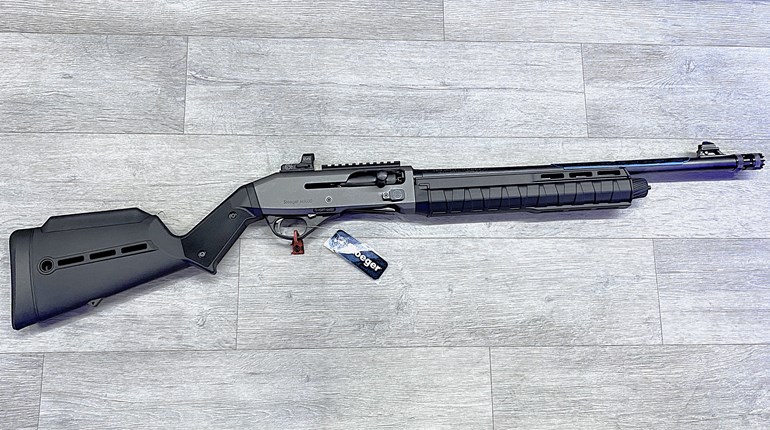
It’s America’s oldest family-owned and operated firearm company. The great grandson of Oscar F. Mossberg, who founded the company in 1919, is CEO today and despite the dramatic changes that have affected the corporate and political landscapes in the last century, the dedication remains to delivering on the firm’s original pledge—“More gun for the money.”
Swedish-born Oscar F. Mossberg immigrated to the United States in 1886, settling in Fitchburg, MA, where he first found gainful employment at a boiler factory. In 1892 he married Alida Peterson and began machining bicycle parts for Iver-Johnson Arms and Cycle Works.
It wasn’t long before supervisors recognized his mechanical aptitude for firearms, and in 1893 he was named on a patent application for a revolver-barrel catch strap. He worked on a variety of patents before leaving the company, often without credit due to his junior staff status. His reputation for inventive, yet simple design grew, however.

He moved to Hatfield, MA, in 1900, where he was production supervisor for C.S. Shattuck Arms, but by 1902 Mossberg was employed by J. Stevens Arms & Tool. There the genius was on full display with his name appearing on a variety of patents. In 1916 he went to work for Marlin-Rockwell, moved to New Haven, CT, and was focused mainly in the manufacture of machine guns for World War I.
 Mossberg branched out on his own in 1919, 100 years ago, establishing the O.F. Mossberg & Sons enthusiasts know more simply and affectionately today as Mossberg. It began in a small rented space in New Haven, with three employees: Oscar, the family patriarch and sons Ivan and Harold. The latter was the sole full-time staff member, because the others were still working for Marlin-Rockwell to keep food on the table.
Mossberg branched out on his own in 1919, 100 years ago, establishing the O.F. Mossberg & Sons enthusiasts know more simply and affectionately today as Mossberg. It began in a small rented space in New Haven, with three employees: Oscar, the family patriarch and sons Ivan and Harold. The latter was the sole full-time staff member, because the others were still working for Marlin-Rockwell to keep food on the table.
Instead of deep-pocketed financing launching the company, it was a tireless work ethic that introduced its first firearm—a handgun called the Brownie. It was chambered for all three lengths of .22 rimfire, had four barrels and a rotating firing pin that allowed it to deliver a single shot at a time until the ammunition was exhausted. A lever atop the backstrap could be depressed, allowing the trigger, barrels and chambers to rotate down for reloading.

Word spread and keeping up with demand for the 37,000 produced before it was phased out in 1932 proved a challenge. The price hovered around a five spot, but in the spirit that still lives at Mossberg, MSRP was reduced for a period when the company was able to tool up to fill the orders. As part of its celebration of the company’s centennial, O.F. Mossberg & Sons introduced the MC1sc in January, its first pistol since the Brownie—in the spirit of “More gun for the money.” Similarly, in true company fashion, MSRP starts at $425.
During the Great Depression, the quality and value offered by Mossberg allowed the company to thrive, while others died. In World War II it was called upon to manufacture a variety of firearms for Allied forces, and in 1962 it introduced the Model 500 shotgun, the company’s most-popular firearm that lives on today.
 “When my great-grandfather opened the door of O.F. Mossberg and Sons in 1919, he instilled a set of corporate operating values that we still live by today,” Iver Mossberg wrote in the company’s 2019 catalog. “Always take care of your employees; always embrace change; always listen to your customers. He coupled those operating values with a commitment to a simple philosophy of providing customers with ‘More Gun for the Money.’ That sort of forward thinking is what allows us to celebrate 100 years of U.S. firearm manufacturing.”
“When my great-grandfather opened the door of O.F. Mossberg and Sons in 1919, he instilled a set of corporate operating values that we still live by today,” Iver Mossberg wrote in the company’s 2019 catalog. “Always take care of your employees; always embrace change; always listen to your customers. He coupled those operating values with a commitment to a simple philosophy of providing customers with ‘More Gun for the Money.’ That sort of forward thinking is what allows us to celebrate 100 years of U.S. firearm manufacturing.”
Richard Kirkland, senior director of marketing for Mossberg, stated, “Being family-owned has had a lasting effect on our employees and the heart and soul they put into every gun. When our employees come to work at Mossberg, they become part of the family, and because of that, they build and treat every gun like they’re building it for themselves.”




































